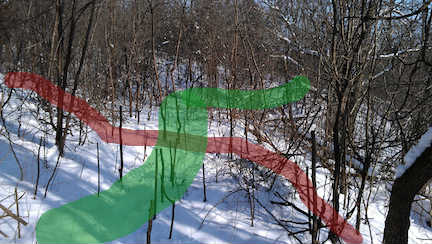In a few weeks some friends will be getting married at the farm so I’m trying to spiff up the place for the occasion. The old tractor that I use for mowing is being a bit temperamental so I’ve used it and the trail mower and a regular four-cycle lawn mower to get the ‘lawn’ under control.
For heaven’s sake! Not only do I have to invest a silly amount of time in cutting all this grass, but I’m using loads of fossil fuel. How resilient is that?!
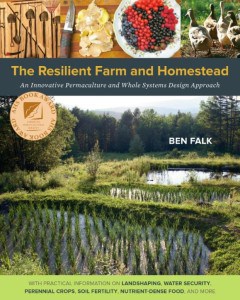 While I’m mowing, I’m pondering Ben Falk’s book, The Resilient Farm and Homestead. Falk writes about 10 years of developing a permaculture-based, low carbon, resilient farm in the hills of Vermont. In contrast to his densely productive land – developed over many years, to be sure – so much of the space in our farmyard is, at present, just a maintenance issue. Sure there are a few apple trees and a fern or two that could provide fiddleheads, but mostly it’s just, well, there – soaking up my time and energy and wasting precious ‘ancient sunlight‘.
While I’m mowing, I’m pondering Ben Falk’s book, The Resilient Farm and Homestead. Falk writes about 10 years of developing a permaculture-based, low carbon, resilient farm in the hills of Vermont. In contrast to his densely productive land – developed over many years, to be sure – so much of the space in our farmyard is, at present, just a maintenance issue. Sure there are a few apple trees and a fern or two that could provide fiddleheads, but mostly it’s just, well, there – soaking up my time and energy and wasting precious ‘ancient sunlight‘.
This is a permaculture problem, isn’t it? I want to make this part of our farm not just lovely to view and pleasant to visit, but both productive and (relatively) low-maintenance. I wonder, could I establish ‘guilds’ under the apple trees so they are happier and healthier and I don’t have to mow under their low hanging branches? Are there other areas of the farmyard that could be, say, planted to herbs, berries or nut bushes or made into a useful outdoor social space? What might thrive under the black walnut trees? besides growing things, what other activities or ecosystem services could or should take place in this area?
The more I think about this the more it seems both that I need a deeper knowledge of permaculture myself and to find some knowledgeable permaculture collaborator(s). Who’s interested?
Fourteen inches of snow on Mayday! C’mon! Wet, heavy, miserable stuff that took out about 30 or 40 trees – I don’t have an exact count. Needless to say I’ve been snuggled up to a chainsaw clearing those that fell onto the fields.
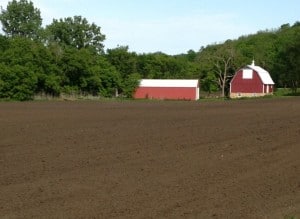
The near west field planted to alfalfa, June 2013.
Then in mid-May a look at the fields indicated that something was wrong. The alfalfa wasn’t coming back. Like so many others in SE Minnesota,I found that the winter rains that froze into solid sheets of ice in the low grounds suffocated the alfalfa. With little time to make a plan, I talked to Todd Churchill from Thousand Hills Cattle Company who agreed to replant and manage the alfalfa for the next three years. Whew!
So now I have the tillable portion of the farm leased for three years with a provision for landshaping and limited permaculture preparations. It’s all been replanted now, and we’ll see how the season unfolds. So far, mostly soggy . . .
Exploring the contours and dynamics of the farm this winter, I’ve begun to glimpse how it may one day work as an integrated whole: wooded hillsides, stream and wetlands, open spaces and pastures. Though it’s only a small farm there are infinite possibilities for interconnected and complementary animals and plants. When asked, “How big is your farm?” I used to answer in the expected form: “55 acres, about 27 tillable” as if only half the farm is useful or productive. How crazy is that! Inspired, in part, by Mark Shepard’s new book Restoration Agriculture, I now imagine someday seeing all 55 acres integrated into a productive, interconnected and largely self-sustaining enterprise.
It’s a huge project and the clearer the vision becomes, the more I realize that what I hope to see is more than I’ll be able to realize on my own. The experienced farmers I know have such an amazing breadth and depth of knowledge – what a greenhorn I am! There is so much to learn needing lots of patient observation, trial, error and time. And there is so much to do: planning, planting, pruning, harvesting, developing markets, managing the finances and all the myriad things that will develop this beautiful place into a beautiful and productive place.
To realize my vision, then, I need one or more partners in the project – folks who would like to help develop a Restoration Agriculture enterprise. In a sense this brings me full circle as one of my original rationales for buying this farm was to provide ‘access to land for sustainable farming.’
The details are still unknown but the broad strokes are clear: here is land to be husbanded for the long haul and the path will likely lead through permaculture. I want to provide access to this land for someone to develop a sustainable, small-scale agricultural enterprise which, over time, would both provide a living and profits, the latter leading to investment in land – perhaps this very farm. For the right partner(s), this could be a thrilling opportunity to create and realize a sustainable farming vision.
There must be someone . . .
Water, water, water! Last summer we learned a lot about the power of water on our farm. Still reeling from last summer, I found that, in his new book Restoration Agriculture, Mark Shepard argues that the first step in making long-term plans for a farm is understanding how water enters, moves through and leaves a farm using the principals of P.A. Yeomans’ ‘Keyline Design‘. With this in mind I ordered a 2-foot contour map from the friendly folks at Goodhue County GIS (Geographic Information Systems).
Here’s the part where I was walking today:
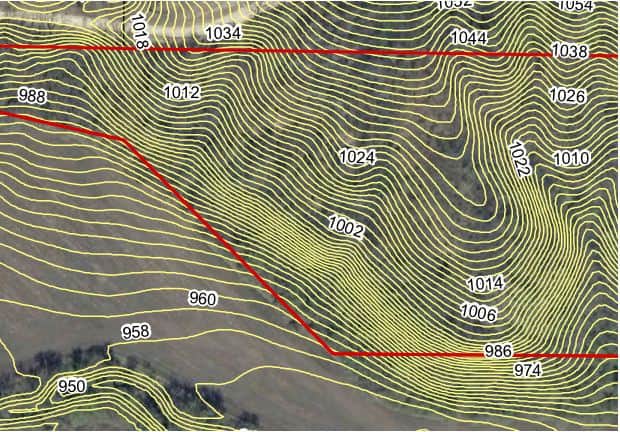
Our ’tillable’ area, now in alfalfa, is at the bottom. You’ll notice a steep slope between those lower fields and the upper area – a degraded prairie. Right at the top of the steepest slope there appears to be a natural path, marked here in red:
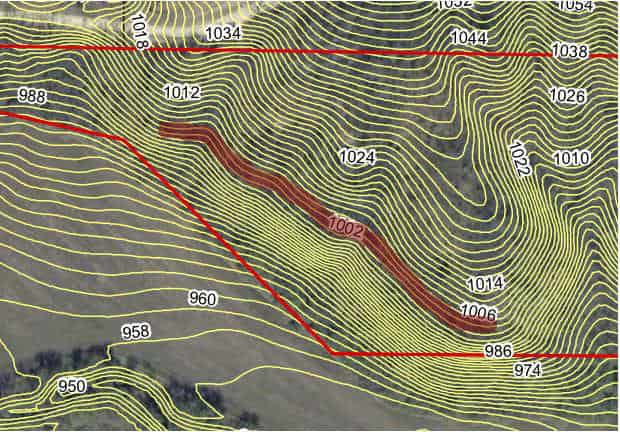
I went looking for this path and sure enough, though the prickly ash and buckthorn had well established, with the leaves down in winter it was clear as could be! Yeomans suggests that contours such as this can be significant both in terms of water flow and the layout of the farm often being useful for roads, windbreaks or fences. With a bit of clearing work, this will provide a natural way to get Doris (the electric UTV) into these woods for hauling brush or other tasks. Down the line this could be a path for critters or people moving from one part of the farm to another.
I’m excited because it looks like a relatively small amount of effort can yield significant access to parts of the farm that have been sealed off by a Sleeping Beauty hedge of prickly ash!
Here’s what I saw today – first is a bit of the trail:
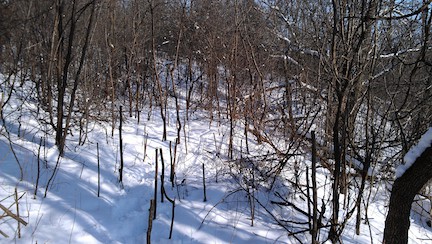
Here is the same bit of trail with the slope of the hill indicated in red and the contour path in green:
Here’s hoping I can wrap my head around the best use of this discovery!

